Here’s 3,000 Years of Spanish History in 3,000 Words
You’ll be shocked at how much history is all around you the first time you visit Spain. Major roads follow the same routes the Romans first trailblazed; your hotel might operate out of a renovated luxury apartment block from the 1800s; and soaring cathedrals still stand today based on 800-year-old technology.
It can be overwhelming if, like me, you grew up in suburban America, where the oldest building dated back to the 1950s and Native American heritage was either scant or ignored. Coming to terms with the sweep of your country’s history is a lot easier when it’s only been around for a few centuries…versus a few millennia.
True to my history major roots, I’ve extensively studied the history of Spain, reading several books and visiting as many cathedrals, castles, and museums as I could in the three years I lived in Spain.
In this post, I’ve distilled 3,000 years of history down to around 3,000 words, saving you from having to read a 500-page textbook before you travel or move to Spain.
By the 1st millennium BCE, Celts and other Indo-European tribes coexisted with descendants of those who had lived in the Iberian peninsula for generations—people like the Vascones, predecessors of modern-day Basques who speak a language related to no other on Earth.
The peninsula’s thousands of miles of strategic coastline left it vulnerable to being colonized by more “advanced” civilizations in the eastern Mediterranean. Greek traders, who set up coastal colonies as far away as the Black Sea and Sicily, also set up trading posts in northeast Iberia, while Phoenicians, straying far from their homeland in what is now Lebanon, established city-states across north Africa and the southern edge of the peninsula that ultimately gave rise to the Carthaginian Empire. Carthage, however, would ultimately lose control of Iberia—and the Mediterranean basin—to Rome during the Punic Wars.
Major destinations: the Cave of El Castillo in Cantabria guards prehistoric cave art dating back 30,000 years; the Dolmens of Antequera are Stonehenge-style mausoleums; and the ruins of Empúries represent one of the earliest Greek settlements on the peninsula.
Under Roman rule, Hispania started out as an extractive colony: mines in the north generated fabulous amounts of gold, while excellent olive oil and garum (fermented fish paste) were a mainstay of Roman kitchens. But Hispania ended up leaving its own mark on the empire. Famous Stoic philosopher Seneca was born in Córdoba, while local sons Trajan and Hadrian reigned as emperors at the height of Rome’s power and territory.
The Roman Empire left a significant legacy, not least of which was the Latin language that blossomed into Galician, Castilian, Catalan, and others. Roman roads linked far-flung corners of the peninsula together, helping spread language as well as politics, philosophy, architecture, law, and public works. Christianity also took root in spite of—and then because of—imperial edicts.
Major destinations: Mérida’s got a theater, forum, temple, monumental arch, aqueduct, amphitheater, circus, and a bridge; the world’s most impressive still-standing aqueduct bisects Segovia; and Lugo is the only city still completely surrounded by an original set of Roman walls.
The collapse of the Roman Empire has been tied to lead poisoning, plagues, a worn-out economy based on conquest, and even Christianity. Whatever the case, Germanic tribes on the other side of the Rhine and Danube rivers had long circled a declining Rome like vultures. At first, they swept in as mercenaries and propped up imperial armies, but later they devoured the empire up by establishing kingdoms in their own right.
In southern Hispania, the Vandals burst in from North Africa, lending their name to Andalucía. But only the Visigoths were able to unite the entire peninsula under a single domain for the first time in several centuries. They largely adopted the language, culture, law, and religion of their Hispano-Roman subjects, although Castilian took on many words of Germanic origin in this period, like guerra (“war”) and yelmo (“helmet”), as well as common names like Alfonso and Rodrigo.
Major destinations: San Millán de la Cogolla’s Suso Monastery dates back to the 500s; the Crypt of San Antolín lies beneath Palencia’s cathedral; and the Church of San Pedro de la Nave in Zamora province was moved stone by stone to prevent destruction when a dam was built.
Muhammad wasn’t even one hundred years dead when the Umayyad Caliphate reached the southern shores of Hispania. Muslim armies initially went on a raiding expedition into what they called al-Andalus, but they quickly overran the Visigothic Kingdom and found themselves in control of a vast empire that stretched from Persia to the Pyrenees.
When the Abbasid dynasty took over the caliphate, deposed prince Abd al-Rahman fled Syria for al-Andalus, where he set up an emirate based in Córdoba that was independent from the caliphate all but in name. Córdoba became the most civilized city in the world, a center of science, translation, and convivencia or “living-togetherness” between Christians, Jews, and Muslims.
The emirate reached the height of its power three centuries later but soon fell into internal strife, dissolving into small city-states called taifas. The taifa period was followed by one fundamentalist dynasty after another that reunified the Muslim-controlled half of the peninsula, but al-Andalus slowly slipped away from the Almoravids and Almohads. Muslim rule shrank to the tiny Emirate of Granada.
The Moors left an incredible legacy on Spain. They revitalized agricultural practices and introduced ingredients now essential in Spanish cuisine: citrus, rice, almonds, and spices. And you can still hear whispers of Arabic in place-names like the Guadalquivir River (from al-Wadi al-Kabir, “Great River”) and words like azahar (from al-zahr, “orange blossom”).
Major destinations: the infinite red-and-white striped arches of Córdoba’s Mosque-Cathedral direct your eyes to a dazzling all-gold mihrab; Zaragoza’s Aljafería fortress is a rare, glamorous example of architecture from the fragmented taifa era; and Islamic art reaches its glorious apex at the Alhambra palace in Granada.
After Muslim armies overran the Visigothic Kingdom, Christian lords fled to Spain’s rugged northern coast, where they made their redoubt and carved out the Kingdom of Asturias. Their victory in a minor skirmish at Covadonga was mythologized into the first battle of the Reconquest, a centuries-long struggle to “take back” Spain from the Muslims. This was never a black-and-white affair, however; the Christian kingdoms of Galicia, León, Castilla, Navarra, and Aragón often went to war with each other, while military alliances and marriages formed across religious boundaries.
Vernacular languages blossomed in the Middle Ages. To be considered educated, you had to know Latin as well as Castilian, the language of the courts, Galician-Portuguese, which the troubadours sang in, and Arabic, which unlocked the knowledge of ancient Greece. Catalan developed in the northeast out of dialects that slipped in from southern France (thanks to Charlemagne).
Around this time, the purported relics of the Apostle St. James the Greater were found in Galicia. A pilgrimage to the shrine honoring the saint drew countless penitents from across Europe—the Camino de Santiago.
As cities from Almería to Zaragoza came under Christian rule, Jews and Muslims were permitted to stay, but restrictions grew and grew.
By the end of the 1400s, the Crown of Castilla had consolidated the various kingdoms and counties that grew out of the Kingdom of Asturias (minus Portugal), while the Crown of Aragón embraced the eastern half of the peninsula, from the Pyrenees south to Valencia.
Major destinations: Santiago de Compostela is the resting place of the supposed remains of St. James, who was said to have assisted Christian troops against the Muslims as Santiago Matamoros (“Moor-Slayer”); Christians, Jews, and Muslims coexisted in an imperfect, yet enduring, community of tolerance in Toledo, where two of Spain’s three medieval synagogues remain; and Teruel is the best place in Spain to appreciate Mudéjar architecture, which combines Gothic forms with Islamic building materials and decorations.
Three events in 1492 set the next 500 years of Spanish history in motion. In January, Fernando and Isabel—the “Catholic Monarchs” of Aragón and Castilla—conquered Granada, ending 700 years of Islamic rule on the peninsula. In March, they ordered all Jews to convert to Catholicism…or get out. Then, in October, Christopher Columbus landed in the Bahamas and immediately started a national quest for God, gold, and glory.
Spain soon controlled an empire that encompassed the whole peninsula, southern Italy, and the Low Countries, plus the Caribbean, Central and South America, and the Philippines.
As the world’s superpower, Spain dominated culture: in literature, Miguel de Cervantes pioneered the novel; in music, Tomás Luis de Victoria crafted polyphonic motets; in art, Diego Velázquez mastered court portraiture; in architecture, Andrés de Vandelvira designed purist Renaissance palaces; and in religion, St. Teresa de Ávila popularized mysticism and reformed monastic life.
Spain seemed unstoppable, and its Armada would lead a multinational navy to victory in the Mediterranean Sea over the Ottoman Turks. However, just a decade later, when King Felipe II tried to claim the English throne from the Protestants by force, the Spanish Armada suffered a shocking defeat.
For all the riches that Spain extracted from the Americas via conquest and forced labor, its rulers chose to get entangled in wars against Protestants, which they lost, for the most part. Instead of investing wealth in industry and diversifying the economy, Spain sent Castilian wool to Dutch mills and let rich farmlands in Valencia lie fallow after expelling Muslims who once tended to them.
Not everyone took kindly to uniform Catholicism. Although many Jews fled Spain for North Africa or the Ottoman Empire, others converted yet continued to practice their traditions in secret. Muslims in the Alpujarras mountains rose up twice against Castilian rule. Many who had nominally converted to Christianity expressed their devoutness in public by eating pork, curing ham, and cooking and baking with lard—culinary customs that still dominate today.
Major destinations: King Felipe II moved the royal court from Madrid to the sprawling monastery-palace-mausoleum called El Escorial; Úbeda underwent a Renaissance building spree when a local son became Secretary of State; and the iconic windmills that dot the countryside of La Mancha were the setting for some of Don Quixote’s most famous antics.
By 1700, the Austrian Habsburg dynasty came to an end with King Carlos II, the sickly, sterile offspring of one too many intermarriages. The resulting War of the Spanish Succession decided who would succeed to the Spanish throne. As part of the peace agreement, the French Bourbon dynasty came to power (current King Felipe VI is a Borbón), but Spain had to give up land in central Europe and Italy, its claims on the French throne, and Gibraltar—which is still a British territory today.
The Nueva Planta decrees punished the regions that had fought on the losing side of this civil war—Aragón, Catalunya, and Valencia—by revoking their charters and privileges and imposing Castilian laws and the Castilian language upon them.
The forward-thinking Bourbons revitalized agriculture in Spain and attempted to introduce the rational ideals of the Enlightenment from France, but often clashed with the landholding Church, the Inquisition, and the nobility.
Modern Spain was born in this century. Ingredients from the Americas (like potatoes and tomatoes) made their way into recipes, bullfighting grew in popularity, flamenco began to be heard in streets in Andalucía, and exuberant Holy Week processions became an expression of popular piety across the country.
Major destinations: Madrid blossomed as the capital of a centralized Spain under King Carlos III, from palaces to parks and everything in between; Aranjuez was built as a royal springtime getaway from Madrid; and old villages on the plains of the central meseta still look much as they did 300 years ago.
Three crises defined Spain in the 1800s. In the Spanish War of Independence, Spaniards fought for six years to take their country back from the French, who had invaded under Napoléon. Spain’s mountainous territory made it easy for civilians to rise up against French troops, giving rise to the term “guerrilla warfare.” With the help of the British, they were able to regain their independence, but they would never be the same.
Mexico and South American colonies took advantage of the upheaval to declare independence, while revolutionary new ideas from France inspired talk of writing constitutions.
The war may have brought people across the country together, inspiring a new sense of “Spanishness,” but Spain was as divided as ever. The Carlist Wars, named for pretender to the throne Don Carlos, split Spanish society into liberal and reactionary conservative camps—the same divisions that would turn neighbors and family members against each other in the Spanish Civil War. Legend has it that Spanish potato omelet, a quick carb- and protein-rich dish, was invented during these wars.
Francisco de Goya’s optimistic portraits of the royal family in the late 1700s, his moving scenes of the War of Independence, and his dark, disturbing pinturas negras expertly capture this century’s descent into instability.
The 19th century closed with the humiliating Spanish-American War. This ten-week conflict with the U.S. stripped Spain of its remaining colonies (Cuba, Guam, the Philippines, and Puerto Rico), decimated its navy, and inspired the literary Generation of ’98 to re-evaluate their now diminished country.
Nevertheless, the Industrial Revolution took hold in Catalunya, where textile mills hummed away, and in the Basque Country, whose iron deposits supported steelworks. Minority languages like Catalan and Galician enjoyed a literary renaissance, and regions in northern Spain began to consider themselves nations within a nation. The Art Nouveau movement inspired fabulous modernista homes and offices to sprout up on new, grand avenues.
Major destinations: Barcelona embraced its role as the capital of industrious Catalunya, tearing down its medieval walls to make way for the gridded Eixample neighborhood; Colonia Güell was a company town for a textile manufacturer who commissioned Antoni Gaudí to build a parish church; and San Sebastián became a wealthy provincial capital as the Basque Country developed.
The Spanish Civil War devastated Spanish society between 1936 and 1939, but it was preceded by years of unstable governments, the rise of anarchists and Marxists, a military dictatorship, the proclamation of a republic, and Catalan separatism.
Francisco Franco led a military uprising against the government of the Second Spanish Republic, uniting the Church, fascists, monarchists, and traditionalists under the Nationalists. Those who still supported the Republic—Basque and Catalan nationalists, Communists, labor unions, liberals, and socialists—were known as Republicans. Pablo Picasso’s most famous work, the mural-sized Guernica, portrays the bombing of the Basque town of Gernika by the German air force. Half a million Spaniards died in the war or as political prisoners, among them Federico García Lorca, the preeminent Spanish poet of the century.
After the war, the victorious Nationalist faction established a totalitarian state with Franco as dictator, but it struggled through a famine and was excluded from the postwar world order. It wasn’t until the ’50s, when the U.S. established military bases in this anti-Communist country, that Spain joined the UN and the economy recovered. Foreign investment quickly picked up, and international tourists flocked to the beaches of the Costa Brava and Costa del Sol.
Franco died in 1975 and the country’s reins passed to King Juan Carlos I, who immediately began work on the Transition to democracy. Spain overwhelmingly ratified a new democratic constitution and raced to reintegrate with the West, joining NATO and the European Community. The newly legal Socialist party came to power and established a universal health care system. And four decades of pent-up hormones and energy exploded into la movida madrileña, Madrid’s throbbing nightlife scene.
In 1992, high-speed rail connected the capital with Sevilla, Expo ’92 commemorated the 500th anniversary of Columbus’ expeditions, and the Summer Olympics put Barcelona on the map as a major tourist hotspot.
Major destinations: the Valley of the Fallen is a memorial built after the Spanish Civil War that also functions as Francisco Franco’s mausoleum; Alicante was one of many beach towns along the Mediterranean that exploded in growth; and Bilbao has transitioned from an industrial afterthought to an artsy, foodie destination.
The conservative People’s Party led Spain into the Iraq War despite huge popular opposition. On March 11, 2004, radical Islamic terrorists set off bombs on four Madrid commuter trains, killing 193 people. President José María Aznar blamed the bombs on Basque nationalist terrorist group ETA, but three days later, Spanish voters punished him for politicizing the response to the attacks and swept the Socialists back into power.
Surprise winner José Luis Rodríguez Zapatero led a government that quickly liberalized Spanish society: the military withdrew from Iraq, same-sex marriage was legalized, and abortion laws were reformed. The Law of Historical Memory even formally denounced Franco’s dictatorship and offered aid to victims and their descendants.
But during the Great Recession, Spain’s housing bubble finally burst, leaving condos partially built and construction workers out of jobs. Power shifted back to the PP, whose leader, Mariano Rajoy, became president in 2011. Despite an economic recovery on paper today, many Spaniards still struggle to get by—especially millennials, nearly half of whom are unemployed.
Prosperous Catalunya enjoys more autonomy than ever. But it resents having to pay taxes to subsidize poorer regions of the country, so it’s attempted to secede from Spain. The PP took a heavy-handed approach to the Catalan problem to bolster its support elsewhere in the country and bury headlines about its Bárcenas slush fund scandal, while the Catalan government has pushed for independence to distract from its own rank corruption.
Voters have soured on the two-party system, turning to left-wing Podemos (“We Can”) and center-right Ciudadanos (“Citizens”) as alternatives. Neither were able to unseat President Rajoy in back-to-back elections in 2015 and 2016. It was political comeback kid Pedro Sánchez who would replace him in 2018’s dramatic vote of no confidence. By 2019, Spaniards returned the Socialists to power in both parliamentary and European elections, but a far-right nationalist party, Vox (“Voice”), entered the arena for the first time since Franco.
Today, tourism is Spain’s third-most-important industry, and 82 million foreigners visited the country in 2017. But as the world’s second-most visited country, Spain is having to reckon with the externalities of mass tourism that risk turning Barcelona into another Venice. How this fascinating nation will decide to protect its rich history and culture while still welcoming travelers from around the globe remains to be seen.
Major destinations: a memorial to the 2004 train bombings stands right outside Madrid’s Atocha train station; Santiago de Compostela’s ambitious Cidade da Cultura was left half-finished after the crash, with excavations and steel framing open to the elements; and Barcelona’s Barri Gòtic is slowly turning into a theme park for cruise ship visitors.
It can be overwhelming if, like me, you grew up in suburban America, where the oldest building dated back to the 1950s and Native American heritage was either scant or ignored. Coming to terms with the sweep of your country’s history is a lot easier when it’s only been around for a few centuries…versus a few millennia.
True to my history major roots, I’ve extensively studied the history of Spain, reading several books and visiting as many cathedrals, castles, and museums as I could in the three years I lived in Spain.
In this post, I’ve distilled 3,000 years of history down to around 3,000 words, saving you from having to read a 500-page textbook before you travel or move to Spain.
Prehistoric Iberia (1,000–200 BCE)
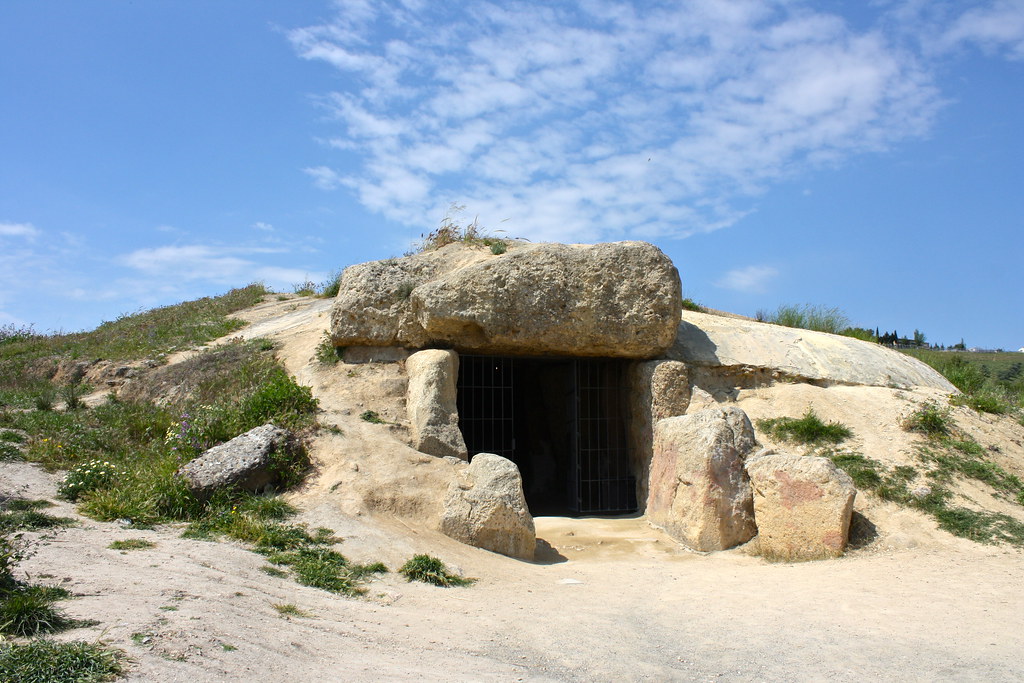 |
| Menga Dolmen, Antequera |
By the 1st millennium BCE, Celts and other Indo-European tribes coexisted with descendants of those who had lived in the Iberian peninsula for generations—people like the Vascones, predecessors of modern-day Basques who speak a language related to no other on Earth.
The peninsula’s thousands of miles of strategic coastline left it vulnerable to being colonized by more “advanced” civilizations in the eastern Mediterranean. Greek traders, who set up coastal colonies as far away as the Black Sea and Sicily, also set up trading posts in northeast Iberia, while Phoenicians, straying far from their homeland in what is now Lebanon, established city-states across north Africa and the southern edge of the peninsula that ultimately gave rise to the Carthaginian Empire. Carthage, however, would ultimately lose control of Iberia—and the Mediterranean basin—to Rome during the Punic Wars.
Major destinations: the Cave of El Castillo in Cantabria guards prehistoric cave art dating back 30,000 years; the Dolmens of Antequera are Stonehenge-style mausoleums; and the ruins of Empúries represent one of the earliest Greek settlements on the peninsula.
Roman Hispania (200 BCE – 400 CE)
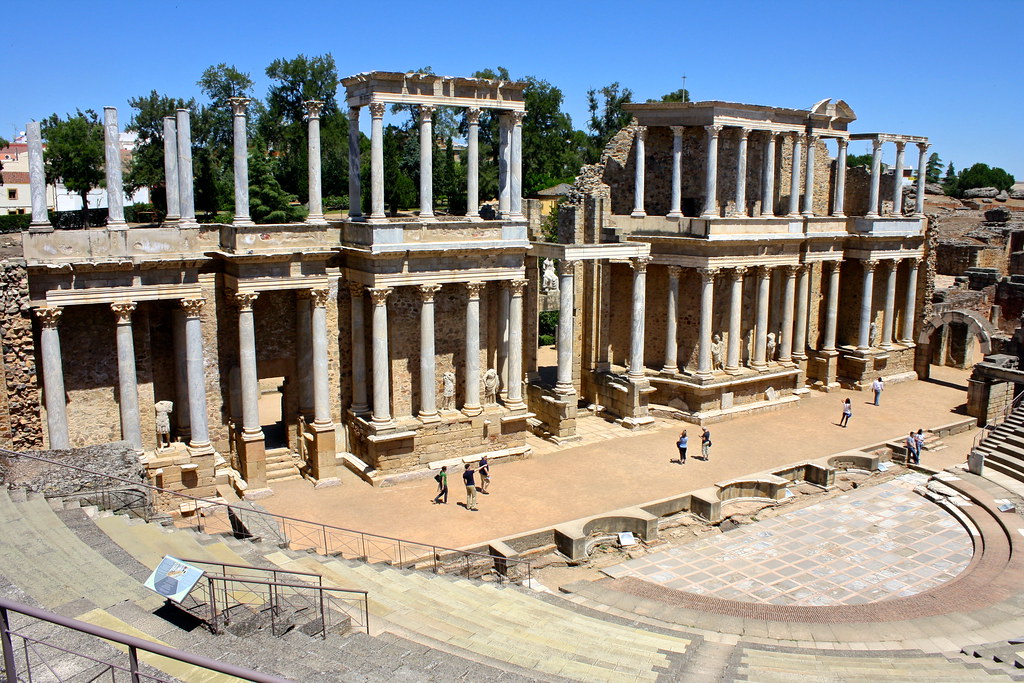 |
| Theater, Mérida |
Under Roman rule, Hispania started out as an extractive colony: mines in the north generated fabulous amounts of gold, while excellent olive oil and garum (fermented fish paste) were a mainstay of Roman kitchens. But Hispania ended up leaving its own mark on the empire. Famous Stoic philosopher Seneca was born in Córdoba, while local sons Trajan and Hadrian reigned as emperors at the height of Rome’s power and territory.
The Roman Empire left a significant legacy, not least of which was the Latin language that blossomed into Galician, Castilian, Catalan, and others. Roman roads linked far-flung corners of the peninsula together, helping spread language as well as politics, philosophy, architecture, law, and public works. Christianity also took root in spite of—and then because of—imperial edicts.
Major destinations: Mérida’s got a theater, forum, temple, monumental arch, aqueduct, amphitheater, circus, and a bridge; the world’s most impressive still-standing aqueduct bisects Segovia; and Lugo is the only city still completely surrounded by an original set of Roman walls.
Barbarians Invade (400–700s CE)
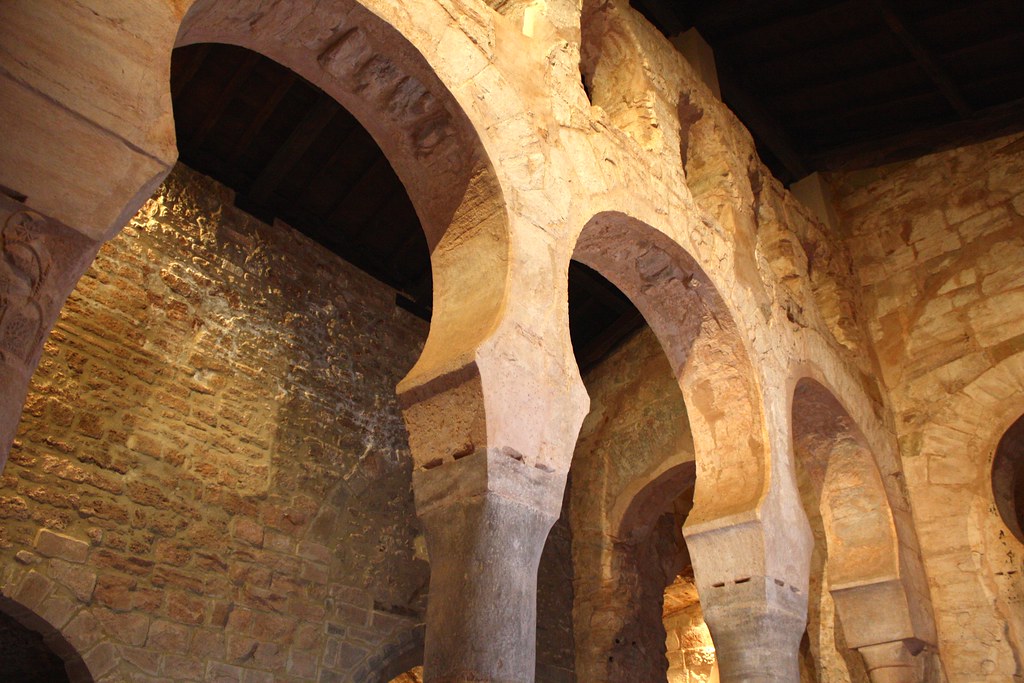 |
| Suso Monastery, San Millán de la Cogolla |
The collapse of the Roman Empire has been tied to lead poisoning, plagues, a worn-out economy based on conquest, and even Christianity. Whatever the case, Germanic tribes on the other side of the Rhine and Danube rivers had long circled a declining Rome like vultures. At first, they swept in as mercenaries and propped up imperial armies, but later they devoured the empire up by establishing kingdoms in their own right.
In southern Hispania, the Vandals burst in from North Africa, lending their name to Andalucía. But only the Visigoths were able to unite the entire peninsula under a single domain for the first time in several centuries. They largely adopted the language, culture, law, and religion of their Hispano-Roman subjects, although Castilian took on many words of Germanic origin in this period, like guerra (“war”) and yelmo (“helmet”), as well as common names like Alfonso and Rodrigo.
Major destinations: San Millán de la Cogolla’s Suso Monastery dates back to the 500s; the Crypt of San Antolín lies beneath Palencia’s cathedral; and the Church of San Pedro de la Nave in Zamora province was moved stone by stone to prevent destruction when a dam was built.
al-Andalus (700s–1400s)
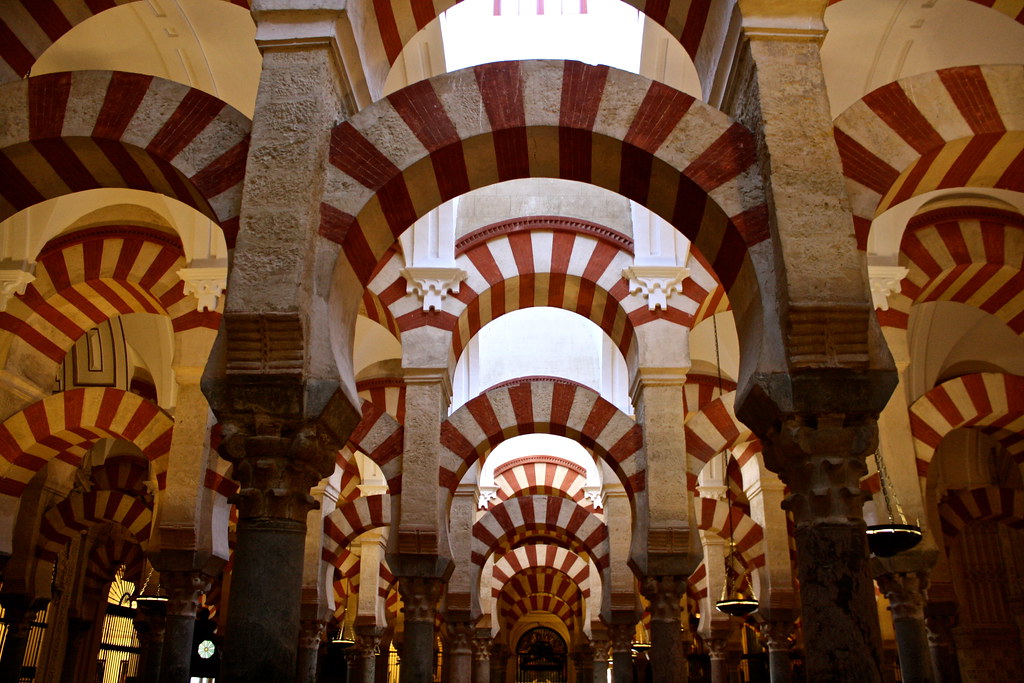 |
| Mosque-Cathedral, Córdoba |
Muhammad wasn’t even one hundred years dead when the Umayyad Caliphate reached the southern shores of Hispania. Muslim armies initially went on a raiding expedition into what they called al-Andalus, but they quickly overran the Visigothic Kingdom and found themselves in control of a vast empire that stretched from Persia to the Pyrenees.
When the Abbasid dynasty took over the caliphate, deposed prince Abd al-Rahman fled Syria for al-Andalus, where he set up an emirate based in Córdoba that was independent from the caliphate all but in name. Córdoba became the most civilized city in the world, a center of science, translation, and convivencia or “living-togetherness” between Christians, Jews, and Muslims.
The emirate reached the height of its power three centuries later but soon fell into internal strife, dissolving into small city-states called taifas. The taifa period was followed by one fundamentalist dynasty after another that reunified the Muslim-controlled half of the peninsula, but al-Andalus slowly slipped away from the Almoravids and Almohads. Muslim rule shrank to the tiny Emirate of Granada.
The Moors left an incredible legacy on Spain. They revitalized agricultural practices and introduced ingredients now essential in Spanish cuisine: citrus, rice, almonds, and spices. And you can still hear whispers of Arabic in place-names like the Guadalquivir River (from al-Wadi al-Kabir, “Great River”) and words like azahar (from al-zahr, “orange blossom”).
Major destinations: the infinite red-and-white striped arches of Córdoba’s Mosque-Cathedral direct your eyes to a dazzling all-gold mihrab; Zaragoza’s Aljafería fortress is a rare, glamorous example of architecture from the fragmented taifa era; and Islamic art reaches its glorious apex at the Alhambra palace in Granada.
The “Reconquest” (700s–1400s)
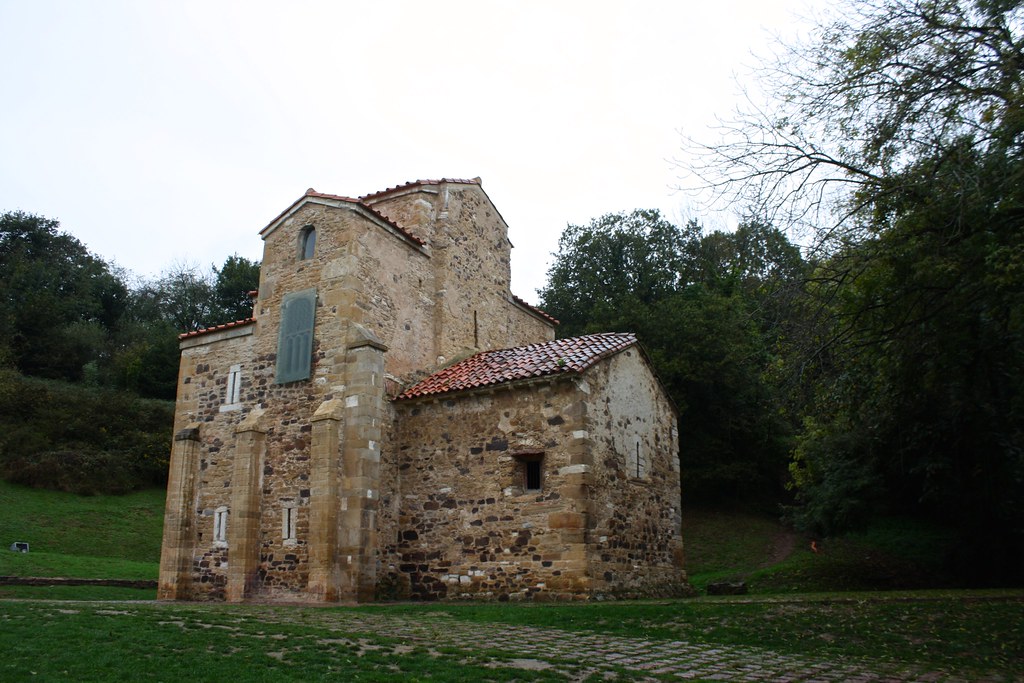 |
| Church of San Miguel de Lillo, Oviedo |
After Muslim armies overran the Visigothic Kingdom, Christian lords fled to Spain’s rugged northern coast, where they made their redoubt and carved out the Kingdom of Asturias. Their victory in a minor skirmish at Covadonga was mythologized into the first battle of the Reconquest, a centuries-long struggle to “take back” Spain from the Muslims. This was never a black-and-white affair, however; the Christian kingdoms of Galicia, León, Castilla, Navarra, and Aragón often went to war with each other, while military alliances and marriages formed across religious boundaries.
Vernacular languages blossomed in the Middle Ages. To be considered educated, you had to know Latin as well as Castilian, the language of the courts, Galician-Portuguese, which the troubadours sang in, and Arabic, which unlocked the knowledge of ancient Greece. Catalan developed in the northeast out of dialects that slipped in from southern France (thanks to Charlemagne).
Around this time, the purported relics of the Apostle St. James the Greater were found in Galicia. A pilgrimage to the shrine honoring the saint drew countless penitents from across Europe—the Camino de Santiago.
As cities from Almería to Zaragoza came under Christian rule, Jews and Muslims were permitted to stay, but restrictions grew and grew.
By the end of the 1400s, the Crown of Castilla had consolidated the various kingdoms and counties that grew out of the Kingdom of Asturias (minus Portugal), while the Crown of Aragón embraced the eastern half of the peninsula, from the Pyrenees south to Valencia.
Major destinations: Santiago de Compostela is the resting place of the supposed remains of St. James, who was said to have assisted Christian troops against the Muslims as Santiago Matamoros (“Moor-Slayer”); Christians, Jews, and Muslims coexisted in an imperfect, yet enduring, community of tolerance in Toledo, where two of Spain’s three medieval synagogues remain; and Teruel is the best place in Spain to appreciate Mudéjar architecture, which combines Gothic forms with Islamic building materials and decorations.
Golden Age Spain (1500s–1600s)
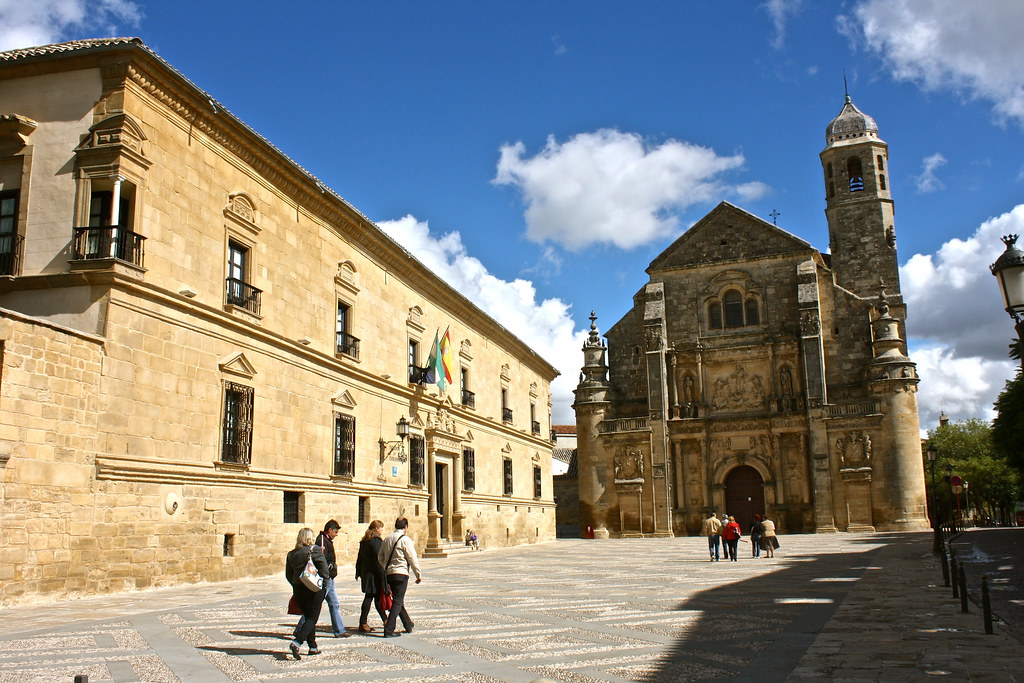 |
| Parador de Úbeda |
Three events in 1492 set the next 500 years of Spanish history in motion. In January, Fernando and Isabel—the “Catholic Monarchs” of Aragón and Castilla—conquered Granada, ending 700 years of Islamic rule on the peninsula. In March, they ordered all Jews to convert to Catholicism…or get out. Then, in October, Christopher Columbus landed in the Bahamas and immediately started a national quest for God, gold, and glory.
Spain soon controlled an empire that encompassed the whole peninsula, southern Italy, and the Low Countries, plus the Caribbean, Central and South America, and the Philippines.
As the world’s superpower, Spain dominated culture: in literature, Miguel de Cervantes pioneered the novel; in music, Tomás Luis de Victoria crafted polyphonic motets; in art, Diego Velázquez mastered court portraiture; in architecture, Andrés de Vandelvira designed purist Renaissance palaces; and in religion, St. Teresa de Ávila popularized mysticism and reformed monastic life.
Spain seemed unstoppable, and its Armada would lead a multinational navy to victory in the Mediterranean Sea over the Ottoman Turks. However, just a decade later, when King Felipe II tried to claim the English throne from the Protestants by force, the Spanish Armada suffered a shocking defeat.
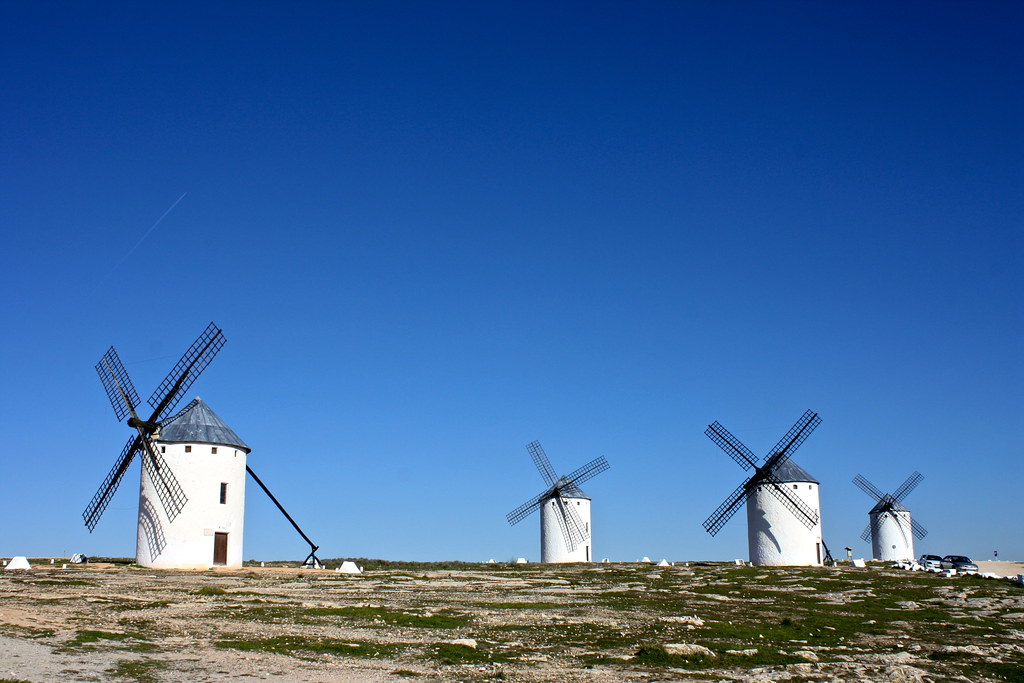 |
| Campo de Criptana windmills |
For all the riches that Spain extracted from the Americas via conquest and forced labor, its rulers chose to get entangled in wars against Protestants, which they lost, for the most part. Instead of investing wealth in industry and diversifying the economy, Spain sent Castilian wool to Dutch mills and let rich farmlands in Valencia lie fallow after expelling Muslims who once tended to them.
Not everyone took kindly to uniform Catholicism. Although many Jews fled Spain for North Africa or the Ottoman Empire, others converted yet continued to practice their traditions in secret. Muslims in the Alpujarras mountains rose up twice against Castilian rule. Many who had nominally converted to Christianity expressed their devoutness in public by eating pork, curing ham, and cooking and baking with lard—culinary customs that still dominate today.
Major destinations: King Felipe II moved the royal court from Madrid to the sprawling monastery-palace-mausoleum called El Escorial; Úbeda underwent a Renaissance building spree when a local son became Secretary of State; and the iconic windmills that dot the countryside of La Mancha were the setting for some of Don Quixote’s most famous antics.
Enlightenment Spain (1700s)
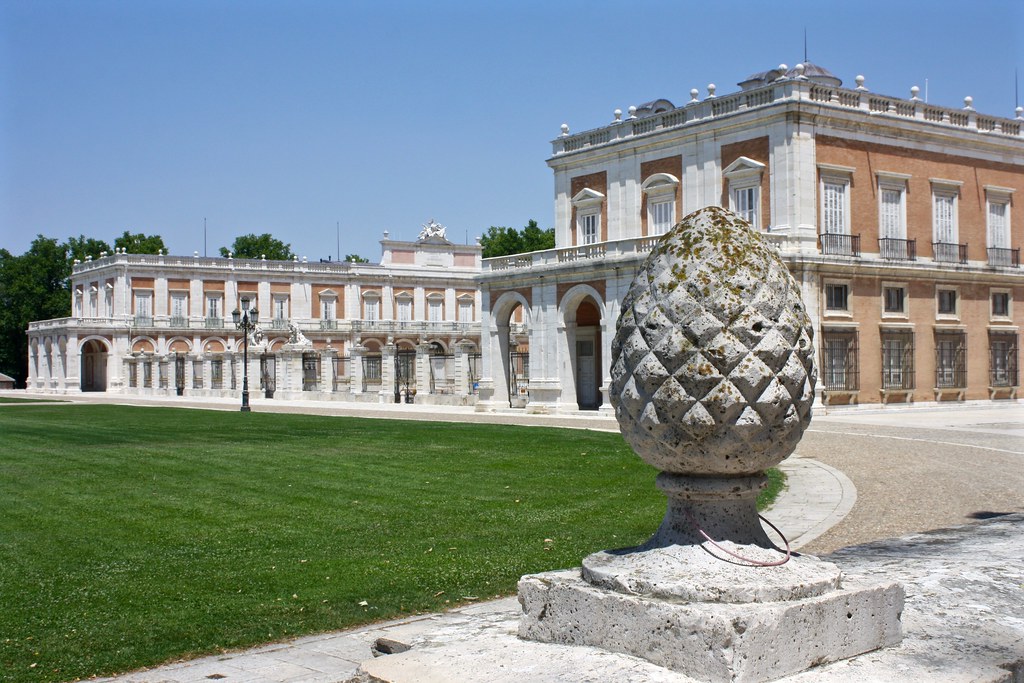 |
| Royal Palace, Aranjuez |
By 1700, the Austrian Habsburg dynasty came to an end with King Carlos II, the sickly, sterile offspring of one too many intermarriages. The resulting War of the Spanish Succession decided who would succeed to the Spanish throne. As part of the peace agreement, the French Bourbon dynasty came to power (current King Felipe VI is a Borbón), but Spain had to give up land in central Europe and Italy, its claims on the French throne, and Gibraltar—which is still a British territory today.
The Nueva Planta decrees punished the regions that had fought on the losing side of this civil war—Aragón, Catalunya, and Valencia—by revoking their charters and privileges and imposing Castilian laws and the Castilian language upon them.
The forward-thinking Bourbons revitalized agriculture in Spain and attempted to introduce the rational ideals of the Enlightenment from France, but often clashed with the landholding Church, the Inquisition, and the nobility.
Modern Spain was born in this century. Ingredients from the Americas (like potatoes and tomatoes) made their way into recipes, bullfighting grew in popularity, flamenco began to be heard in streets in Andalucía, and exuberant Holy Week processions became an expression of popular piety across the country.
Major destinations: Madrid blossomed as the capital of a centralized Spain under King Carlos III, from palaces to parks and everything in between; Aranjuez was built as a royal springtime getaway from Madrid; and old villages on the plains of the central meseta still look much as they did 300 years ago.
Crises of the 1800s
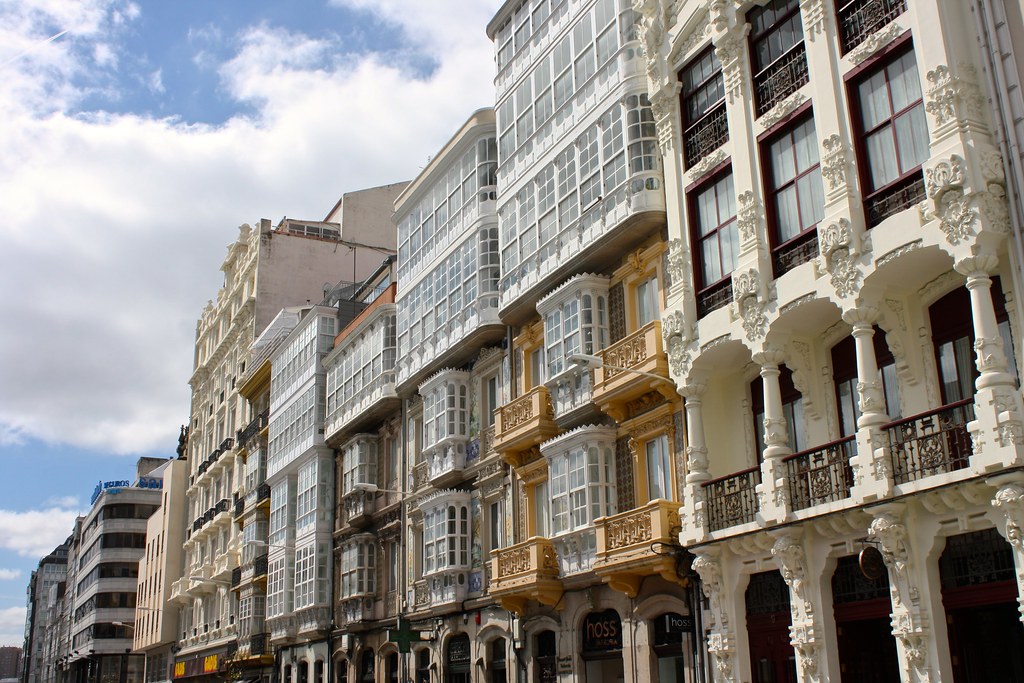 |
| Modernista-style houses, A Coruña |
Three crises defined Spain in the 1800s. In the Spanish War of Independence, Spaniards fought for six years to take their country back from the French, who had invaded under Napoléon. Spain’s mountainous territory made it easy for civilians to rise up against French troops, giving rise to the term “guerrilla warfare.” With the help of the British, they were able to regain their independence, but they would never be the same.
Mexico and South American colonies took advantage of the upheaval to declare independence, while revolutionary new ideas from France inspired talk of writing constitutions.
The war may have brought people across the country together, inspiring a new sense of “Spanishness,” but Spain was as divided as ever. The Carlist Wars, named for pretender to the throne Don Carlos, split Spanish society into liberal and reactionary conservative camps—the same divisions that would turn neighbors and family members against each other in the Spanish Civil War. Legend has it that Spanish potato omelet, a quick carb- and protein-rich dish, was invented during these wars.
Francisco de Goya’s optimistic portraits of the royal family in the late 1700s, his moving scenes of the War of Independence, and his dark, disturbing pinturas negras expertly capture this century’s descent into instability.
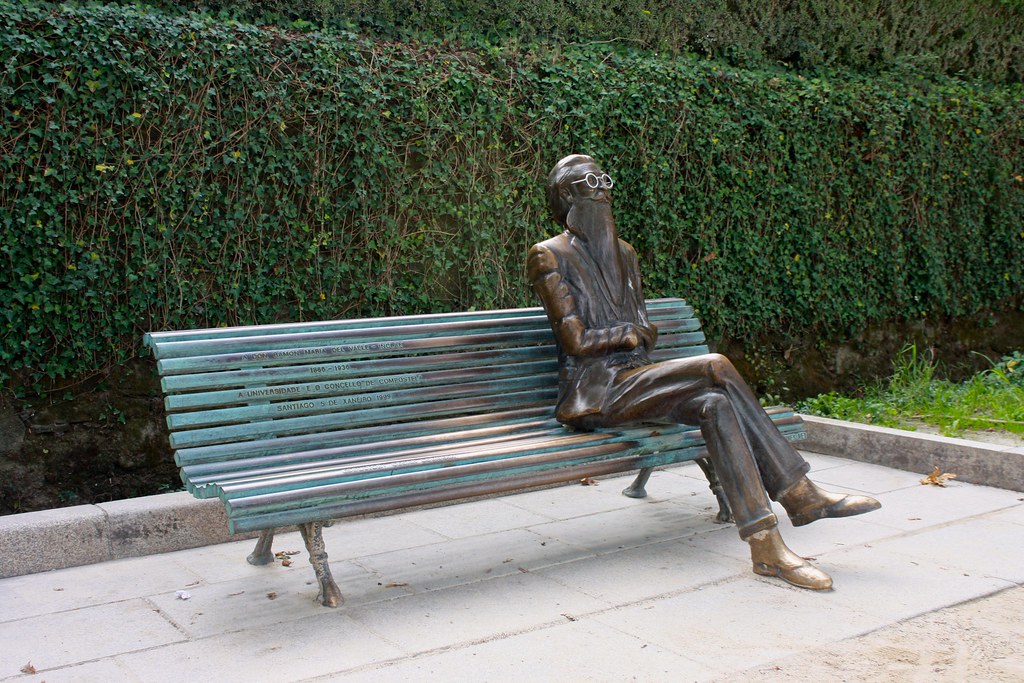 |
| Statue of writer Ramón del Valle-Inclán, Santiago de Compostela |
The 19th century closed with the humiliating Spanish-American War. This ten-week conflict with the U.S. stripped Spain of its remaining colonies (Cuba, Guam, the Philippines, and Puerto Rico), decimated its navy, and inspired the literary Generation of ’98 to re-evaluate their now diminished country.
Nevertheless, the Industrial Revolution took hold in Catalunya, where textile mills hummed away, and in the Basque Country, whose iron deposits supported steelworks. Minority languages like Catalan and Galician enjoyed a literary renaissance, and regions in northern Spain began to consider themselves nations within a nation. The Art Nouveau movement inspired fabulous modernista homes and offices to sprout up on new, grand avenues.
Major destinations: Barcelona embraced its role as the capital of industrious Catalunya, tearing down its medieval walls to make way for the gridded Eixample neighborhood; Colonia Güell was a company town for a textile manufacturer who commissioned Antoni Gaudí to build a parish church; and San Sebastián became a wealthy provincial capital as the Basque Country developed.
Civil War, Dictatorship, & Democracy (1900s)
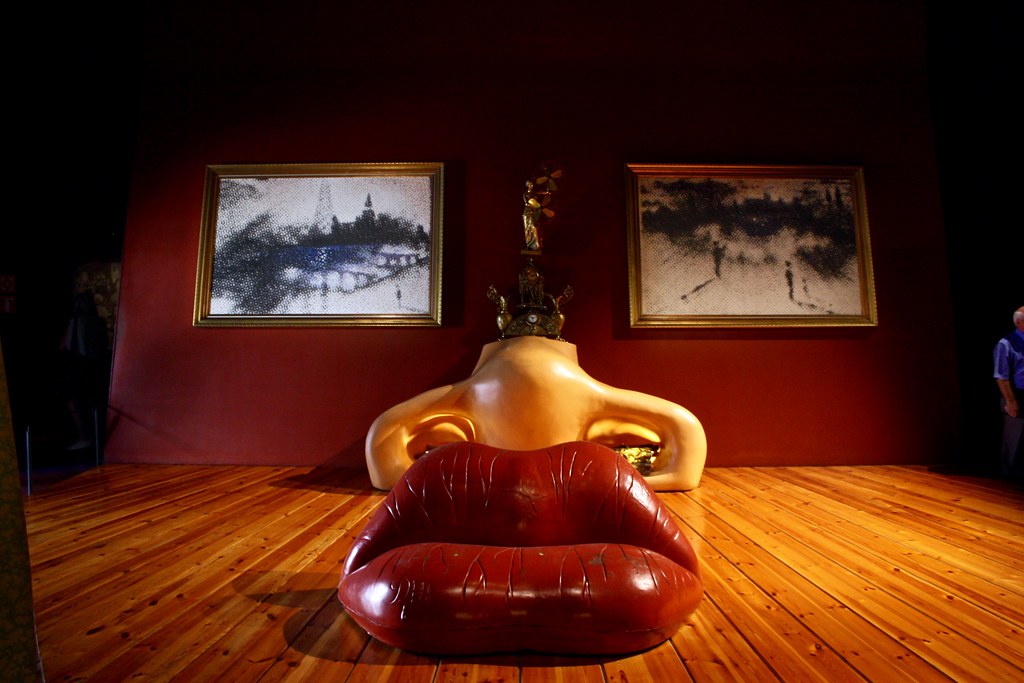 |
| Dalí Theater-Museum, Figueres |
The Spanish Civil War devastated Spanish society between 1936 and 1939, but it was preceded by years of unstable governments, the rise of anarchists and Marxists, a military dictatorship, the proclamation of a republic, and Catalan separatism.
Francisco Franco led a military uprising against the government of the Second Spanish Republic, uniting the Church, fascists, monarchists, and traditionalists under the Nationalists. Those who still supported the Republic—Basque and Catalan nationalists, Communists, labor unions, liberals, and socialists—were known as Republicans. Pablo Picasso’s most famous work, the mural-sized Guernica, portrays the bombing of the Basque town of Gernika by the German air force. Half a million Spaniards died in the war or as political prisoners, among them Federico García Lorca, the preeminent Spanish poet of the century.
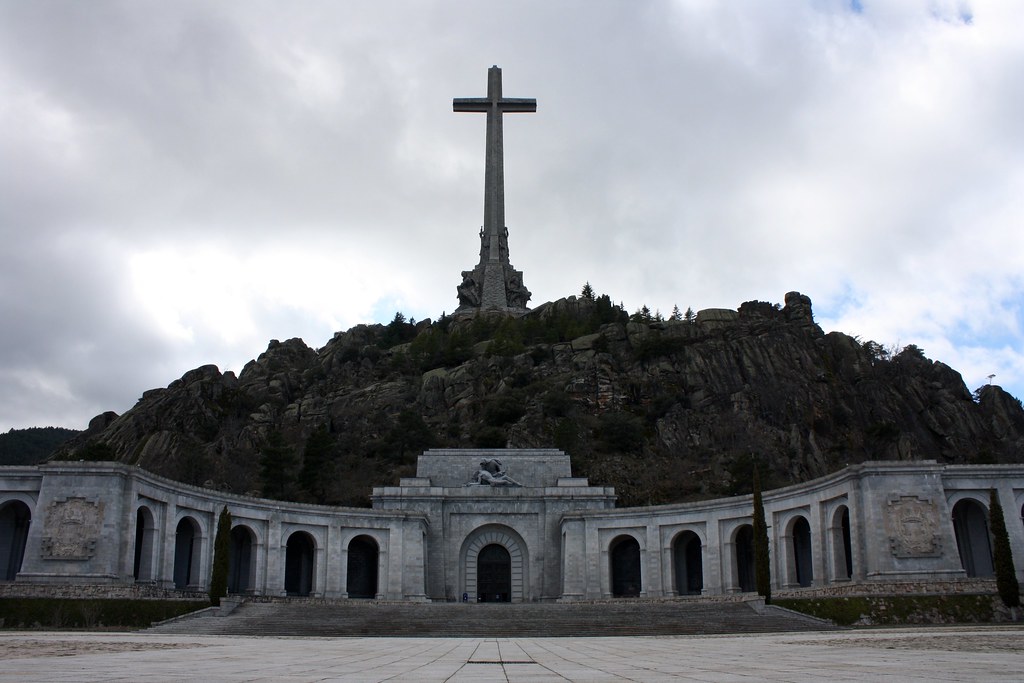 |
| Valley of the Fallen, San Lorenzo de El Escorial |
After the war, the victorious Nationalist faction established a totalitarian state with Franco as dictator, but it struggled through a famine and was excluded from the postwar world order. It wasn’t until the ’50s, when the U.S. established military bases in this anti-Communist country, that Spain joined the UN and the economy recovered. Foreign investment quickly picked up, and international tourists flocked to the beaches of the Costa Brava and Costa del Sol.
Franco died in 1975 and the country’s reins passed to King Juan Carlos I, who immediately began work on the Transition to democracy. Spain overwhelmingly ratified a new democratic constitution and raced to reintegrate with the West, joining NATO and the European Community. The newly legal Socialist party came to power and established a universal health care system. And four decades of pent-up hormones and energy exploded into la movida madrileña, Madrid’s throbbing nightlife scene.
In 1992, high-speed rail connected the capital with Sevilla, Expo ’92 commemorated the 500th anniversary of Columbus’ expeditions, and the Summer Olympics put Barcelona on the map as a major tourist hotspot.
Major destinations: the Valley of the Fallen is a memorial built after the Spanish Civil War that also functions as Francisco Franco’s mausoleum; Alicante was one of many beach towns along the Mediterranean that exploded in growth; and Bilbao has transitioned from an industrial afterthought to an artsy, foodie destination.
The Bubble Bursts (2000–present)
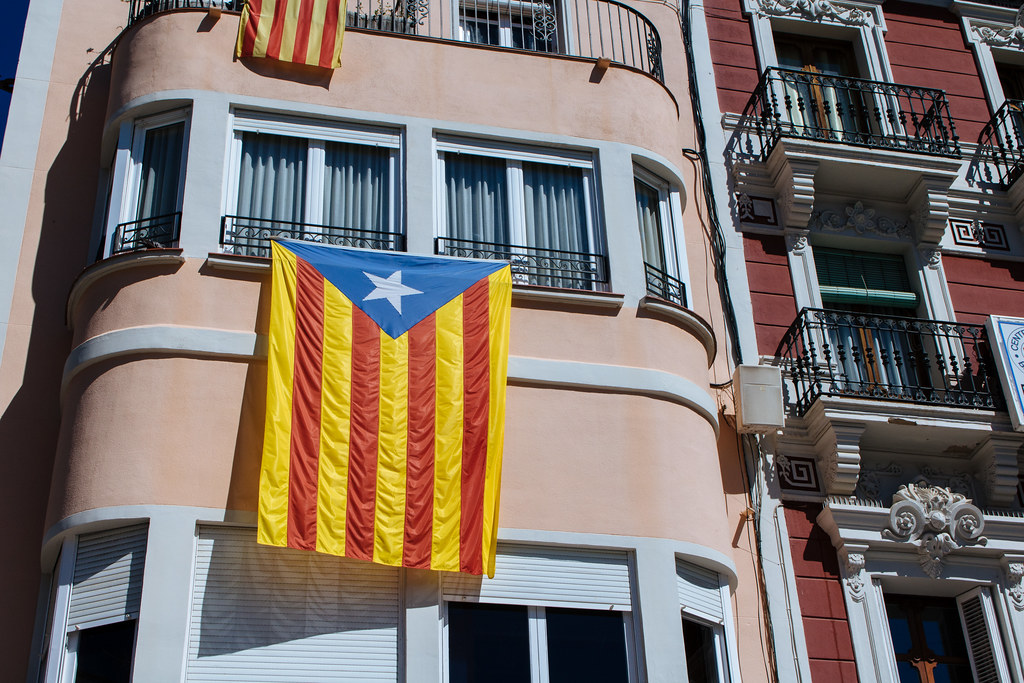 |
| Catalan independence flag, Reus |
The conservative People’s Party led Spain into the Iraq War despite huge popular opposition. On March 11, 2004, radical Islamic terrorists set off bombs on four Madrid commuter trains, killing 193 people. President José María Aznar blamed the bombs on Basque nationalist terrorist group ETA, but three days later, Spanish voters punished him for politicizing the response to the attacks and swept the Socialists back into power.
Surprise winner José Luis Rodríguez Zapatero led a government that quickly liberalized Spanish society: the military withdrew from Iraq, same-sex marriage was legalized, and abortion laws were reformed. The Law of Historical Memory even formally denounced Franco’s dictatorship and offered aid to victims and their descendants.
But during the Great Recession, Spain’s housing bubble finally burst, leaving condos partially built and construction workers out of jobs. Power shifted back to the PP, whose leader, Mariano Rajoy, became president in 2011. Despite an economic recovery on paper today, many Spaniards still struggle to get by—especially millennials, nearly half of whom are unemployed.
Prosperous Catalunya enjoys more autonomy than ever. But it resents having to pay taxes to subsidize poorer regions of the country, so it’s attempted to secede from Spain. The PP took a heavy-handed approach to the Catalan problem to bolster its support elsewhere in the country and bury headlines about its Bárcenas slush fund scandal, while the Catalan government has pushed for independence to distract from its own rank corruption.
Voters have soured on the two-party system, turning to left-wing Podemos (“We Can”) and center-right Ciudadanos (“Citizens”) as alternatives. Neither were able to unseat President Rajoy in back-to-back elections in 2015 and 2016. It was political comeback kid Pedro Sánchez who would replace him in 2018’s dramatic vote of no confidence. By 2019, Spaniards returned the Socialists to power in both parliamentary and European elections, but a far-right nationalist party, Vox (“Voice”), entered the arena for the first time since Franco.
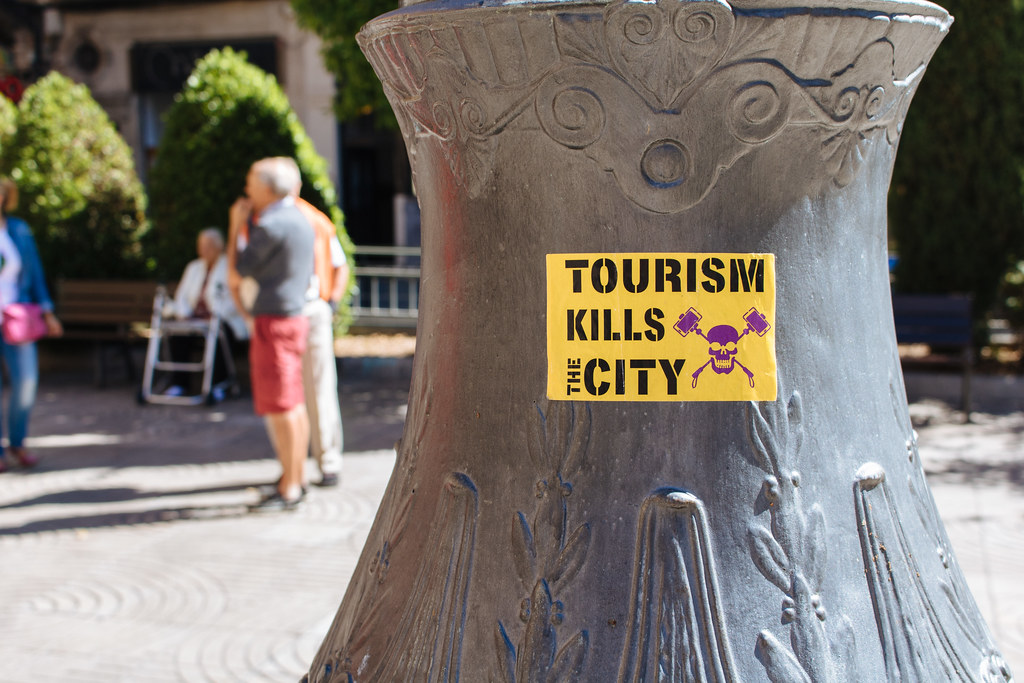 |
| Anti-tourism sticker, Reus |
Today, tourism is Spain’s third-most-important industry, and 82 million foreigners visited the country in 2017. But as the world’s second-most visited country, Spain is having to reckon with the externalities of mass tourism that risk turning Barcelona into another Venice. How this fascinating nation will decide to protect its rich history and culture while still welcoming travelers from around the globe remains to be seen.
Major destinations: a memorial to the 2004 train bombings stands right outside Madrid’s Atocha train station; Santiago de Compostela’s ambitious Cidade da Cultura was left half-finished after the crash, with excavations and steel framing open to the elements; and Barcelona’s Barri Gòtic is slowly turning into a theme park for cruise ship visitors.
Further Reading
- Fletcher, Richard. Moorish Spain. Los Angeles: University of California Press, 2006.
- Hooper, John. The New Spaniards. 2nd Edition. New York: Penguin Books, 2006.
- Menocal, María Rosa. Ornament of the World: How Muslims, Jews, and Christians Created a Culture of Tolerance in Medieval Spain. New York: Back Bay Books, 2002.
- Tremlett, Giles. Ghosts of Spain: Travels Through Spain and Its Silent Past. New York: Walker & Company, 2008.
- Williams, Mark R. The Story of Spain. San Mateo, Calif.: Golden Era Books, 2009.
